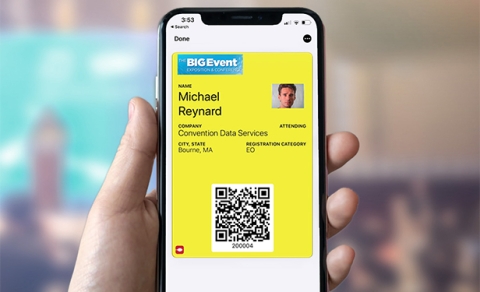How Technology Can Maintain Safety at Trade Shows

When discussing the future of trade shows, Convention Data Services President and CEO John Kimball draws an analogy to Walt Disney World. With one click of a button, a guest has for years been able to gauge the length of ride lines and determine his or her group’s next stop.
“Nobody wants to wait in line,” Kimball said.
This is especially true when registering for a conference. Before, long lines were a mere (or more) nuisance upon arrival. But in the coronavirus era, annoyance turns to unsafe as congestion in exhibition halls risks the spread of a once-in-a-century disease.
What if those lines could be eliminated forever? It turns out they can, as attendees will discover when they begin transitioning back to in-person even after more than a year of Zoom calls and the occasional virtual event.
While vaccine distribution is picking up steam, few attendees, exhibitors or planners truly expect a quick return to normal. Health and safety measures will likely resemble what groups that have forged ahead with in-person events are already doing. So while you won’t be able to throw away that mask just yet, make no mistake about it, trade shows will be different.
Flipping the Switch
Much of the “new” advancements created to keep trade shows safe during COVID-19 have been around for years. Just consider the technology being rolled out for when the world re-opens to be ahead of its time.
Look for planners to adopt tools that limit long lines, track attendees, measure crowds in a room and do away with much of an event’s paper trail. That doesn’t sound novel or strange, does it?
“Honestly, we’ve been talking about this stuff because we’ve seen the value and the need for it in the industry,” said Kimball. “It’s just hard to gain adoption.”
CDS is among the companies preparing for this brave new trade show world with ideas that made sense even before the pandemic. The goals remain the same: Maximize value for planners and organizations while providing a welcoming experience to attendees and exhibitors.
“Hybrid” is the most common term in the events industry. At its basic level, it means blending a physical event with a digital experience for those at home. Kimball is convinced that digital will also bleed into the trade show floor and exhibition venue.
Here are some ways technology is going to pave the way forward.
- No lines. Groups may finally be ready for a digital badge first conceived of by CDS almost a decade ago. Think of it as turning your phone into a digital ticket similar to what’s been done at concerts, sports events and movies for years.
Takeaway: When coupled with shipping swag bags to attendees before the show, there isn’t a need to head to the registration table. And when entering the expo hall, buyers and exhibitors can get their phones scanned while remaining socially distant.
Value added: The technology allows planners a better way to know where attendees are at all times. If there are tiered-passes for different experiences based on payment or VIP experience, the pass would be able to stop someone without that access to enter. Similarly, if media is excluded from the trade show floor, the technology would enforce the rules.
- Crowd limits. Before COVID, fire codes were the barometer to measure if a room is too crowded. With destinations having differing degrees of openness, planners will need to know how many people are in a room at all times. CDS offers a density management tool via an app. Say, for example, if only 250 attendees are allowed in a room at one time, knowing when to shut the doors will be key.
Takeaway: Safety can’t just be a motto. If a threshold is broken, so is trust between attendees and the host organization.
Value added: On the flip side, if the trade show floor isn’t buzzing like a planner would want, he or she can send out a push notification to drive traffic to exhibitors.
- Matchmaking. Luring window shoppers is part of the trade show game. But exhibitors prize pre-set appointments with the buyers they are targeting. Digital badges start the meeting process before the show, building in time to create one-on-one slots.
Takeaway: Even after peak vaccine distribution, there will be attendees wary of large groups. Pre-set times limit the risk of intrusion, ideal for peace of mind and for eliminating distractions.
Value added: Meeting with the right people is how business gets done. The more business deals that can be traced to a trade show, the greater the event’s reputation. The greater the reputation, more attendees opt to attend in-person in the future.
- Information exchange. Planners and event organizers aren’t the only ones looking to glean information. Attendees want to know what exhibitors have to offer. They also do not want to bring back a bunch of pamphlets and extraneous publications. CDS has a digital backpack that can store presentations, information and more about products.
Takeaway: Again, crowds at a booth can be a serious deterrent, especially when many attendees will be on-edge about germs. One tap of a button transfers relevant data, just without the face-to-face interaction (a bonus for introverts).
Value added: Just consider how much less paper is needed with tools like these. This is just one example of how sustainability in a pandemic is possible.
Don’t miss any event-related news: Sign up for our weekly e-newsletter HERE and engage with us on Twitter, Facebook, LinkedIn and Instagram!


Add new comment